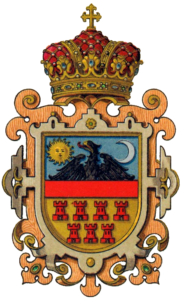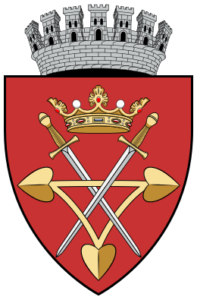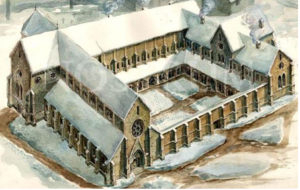Szeben and the Abbey of Kerc

Szeben / Nagyszeben (Sibiu, Hermannstadt) is located in Transylvania, Romania. The majestic ruins of the Abbey of Kerc (Kerz) are not far from the city. Szeben was a medieval royal and free Hungarian city in southern Transylvania and became the spiritual and commercial center of the German Saxons. The old town of (Nagy) Szeben, once the center of the Transylvanian Saxons, was ranked “Europe’s 8th most idyllic place to live” by Forbes in 2008.

The town was founded by King Géza II of Hungary, who invited the Saxons to his kingdom around 1050. It was first mentioned in writing as “Cipin” in 1191. In the 14th century, it was already an important trade center. In 1376 the craftsmen were divided into 19 guilds. Szeben became the most important ethnic German city among the seven cities that gave Transylvania its German name “Siebenbürgen” (meaning “seven cities”). You can find them in the COA of Transylvania, together with the symbols of the Hungarian Székelys (the sun and the moon) and the Hungarians (the Turul bird). The Saxon Seats (centers) were the next: Kőhalom (Reps, Rupea), Medgyes (Medwisch, Mediaș), Nagysink (Groß-Schenk, Cincu), Sebes (Melnbach, Sebeș), Szeben (Hermannstadt, Sibiu), Szászváros (Bros, Orăștie), Szerdahely (Reismuert, Miercurea Sibiului).

Here is more about the Saxons of Transylvania, whose disappearance from Transylvania in the 20th century left a painful void:
https://www.hungarianottomanwars.com/essays/who-were-the-german-saxons-in-transylvania/
Szeben was the home of the Universitas Saxorum (Community of the Saxons), a network of educators, ministers, intellectuals, city officials, and councilors of the German community that forged an ordered legal corpus and political system in Transylvania since the 1400s. It was the center of the Roman Catholic administration of the Saxons until the end of the 15th century.

Hunyadi János, Governor of Hungary, defeated the army of Bey Mezid in 1444 in front of its strong walls defended by forty bastions. (Please note that I use the Oriental name order for Hungarians, where the surname comes first). The Turks were never able to take it, but there was a great fire in 1556. We know that the first printing press in Transylvania was established there in 1529. Soon the city became one of the centers of the Reformation.

After the unfortunate Polish campaign of Prince Rákóczi György II, the Crimean Tatar raiders plundered the city in 1658. The Saxons were one of the three “nations” of Transylvania, and sometimes they didn’t obey the Transylvanian princes, similar to the Székelys. We can see that the city was besieged by Prince Rákóczi György II in 1659.

Szeben was the city where the Transylvanian nobility swore allegiance to Emperor Leopold I in 1688, thus breaking the principality’s loyalty to the Ottoman Empire. It was also the place where they decided to elect Thököly Imre as their prince two years later.

Szeben was the capital of the Principality of Transylvania between 1692 and 1791 and 1849-65 and played an important role in the Hungarian War of Independence in 1848-49. The Saxons repelled the Hungarian attack on January 31, 1849, but General Bem recaptured the city in an ambush on March 11. After the end of the revolution, the fortified gates of the city were demolished one by one in the 19th century, but we can still see many parts of the city wall and several towers that survived as well.

The Romanian Army took the city in 1916 after a particularly fierce siege, but it was soon retaken by the Austro-Hungarian and German troops in an equally fierce battle. On 10 December 1918, Nagyszeben and Marosújvár fell into Romanian hands. At that time, it was the only Saxon city among the large cities with a German majority. The city of 38,000 inhabitants had 20,000 Saxons, 7,000 Hungarians, and 10,000 Romanians. Today, the city has a population of about 150,000, with more than 130,000 Romanians, 2,000 Hungarians, and 1,500 Germans.

Here are a few videos that I can recommend to you, the first is a longer one, it is in the Hungarian language:
https://www.youtube.com/watch?v=pDl1IiTWyjU
and this one is in English:
https://www.youtube.com/watch?v=_rCw-dOFxdo
But the best thing is to visit and see this fabulous city with your own eyes. Check out the pictures in the gallery at the end of this article and enjoy the sights of this very special city.

The Abbey of Kerc
Kerc (Kloster Kerz, Mănăstirea Cârța) is a former Cistercian (Benedictine) monastery in the Fogaras region of southern Transylvania in Romania, currently a Lutheran Evangelical church belonging to the local Saxon community.

Enjoy the video:
https://www.youtube.com/watch?v=HHOa4tSWrOE
Kerc is situated on the left bank of the river Olt, between the towns of Szeben and Fogaras. It was founded between 1198 and 1202 by King Imre, who invited monks and architects from France. At first, there was only a wooden church, but the French monks soon replaced it with a stone building. The church was surrounded by a stone wall in 1230.

The Mongols attacked it in 1241, but it was rebuilt in 1247. The new church was reconstructed by combining elements of late Romanesque and early Gothic styles, following French examples. Around 1300, the church and the east wing of the Kerc Abbey were already finished, and the works on the south side continued for about two decades.

King Kun László kept the Holy Crown of Hungary there in 1262, and the Cumans besieged the Abbey at that time. King Károly Róbert granted the Abbey further privileges in 1322.

In 1357, there were 12 monks in the abbey who not only prayed and preached but also copied codexes. They also had the right to issue documents. We know a document of King Zsigmond from 1398 in which Kerc is mentioned: it says that many ancestors of the Hungarian kings are buried in the church.

In the first half of the 15th century, the abbey had to face several Ottoman and Wallachian attacks and raids, and the monks were not strong enough to defend it.

Finally, it was King Matthias Corvinus who deprived the abbey of its privileges in 1469 and attached it to the provostry of Szeben. Then the Abbey of Kerc began to decline. The cathedral and the walls were already in a very bad condition in the 16th century. However, the tower built in 1495 is still standing, as well as the two-story western part of the wall.

Unfortunately, the northern nave and the basement of the chapel collapsed in 1648. The Lutheran Saxons of Szeben, who were the official caretakers of the Catholic church, didn’t spend much money on it. Later the sanctuary was rebuilt and now it is a functioning Lutheran church. It’s worth a visit because you won’t see such Gothic wonders further east in Europe.

Dear Readers, I can only make this content available through small donations or by selling my books or T-shirts.
If you like my writings, please feel free to support me with a coffee here:
You can check out my books on Amazon or Draft2Digital, they are available in hardcover, paperback, or ebook:
https://www.amazon.com/dp/198020490X or at https://books2read.com/b/boYd81

My work can also be followed and supported on Patreon: Become a Patron!http://Become a Patron!











































